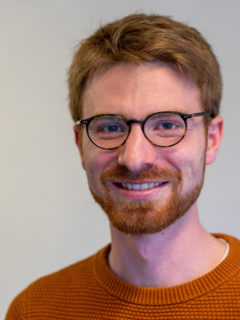Herrnböck, Ludwig, M.Sc.
Dr.-Ing. Ludwig Herrnböck
-
Micro-resolved finite element modeling and simulation of nonwovens
(Third Party Funds Single)
Term: 1. June 2021 - 31. May 2023
Funding source: Deutscher Akademischer Austauschdienst (DAAD)The goal of this project is to develop a modelling and simulation technique enabling:
(i) the generation of nonwoven unit cell models according to a given set of structure parameters (size, density/grammage, orientation distribution function, fiber properties, …) and relying on a sophisticated beam discretization and formulation extended to contact treatment
(ii) the simulation of the relevant processing steps, i.e. the densification and bond point genera-tion, whereby, for simplicity, only isothermal processes are initially considered and the newly formed bond points are introduced via Dirichlet boundary conditions confining the nonwoven unit cell
(iii) deformation simulations (uniaxial, biaxial, bending,…) under due consideration of fiber proper-ties and contact behavior, validation against experimental data -
Mesoscopic modelling and simulation of properties of additively manufactured metallic parts (C5)
(Third Party Funds Group – Sub project)
Overall project: CRC 814 - Additive Manufacturing
Term: 1. July 2019 - 30. June 2023
Funding source: DFG - Sonderforschungsbereiche
URL: https://www.crc814.research.fau.eu/projekte/c-bauteile/teilprojekt-c5/Based on the gained knowledge of projects B4 and C5,the aim of this project is to account for the influence of part borders on theresulting material/part-mesostructure for powder- and beam-based additivemanufacturing technologies of metals and to model the resulting meso- andmacroscopic mechanical properties. The mechanical behavior of thesemesostructures and the influence of the inevitable process-based geometricaluncertainties is modelled, verified, quantified and validated especially forcellular grid-based structures. -
Investigation of residual stress related elementary processes in cold forged components in the manufacturing and operating phase
(Third Party Funds Single)
Term: 1. February 2018 - 31. December 2022
Funding source: DFG-Einzelförderung / Sachbeihilfe (EIN-SBH)Due to the potential of forming induced residual stresses to influence component properties, a deeper understanding of the mechanisms of residual stress generation and stability is required. Therefore, the approach to the research project is structured into the phases of component manufacturing (generation of residual stresses), component operation (residual stress stability) and process design (exploitation of residual stresses). As reference process the forward rod extrusion is used, which is established as standard process in industrial use. Due to the trend towards component materials with higher strength and corrosion resistance, two stainless steels are used in the project. The investigations include parallel experimental and numerical analyses of the process and its synthesis.During the first phase, the necessary experimental equipment for component manufacture and testing was set up, material and friction parameters were identified, components were formed under consideration of different parameter variants and their residual stresses were determined by X-ray diffraction. In a complementary approach, macroscopic finite element models with subroutines for an extended post-processing of residual stresses were developed on the simulation side and applied in the context of numerical parameter variations. Furthermore, differential geometric and continuum mechanical relationships of residual stresses were investigated and the material modelling was extended to crystal plasticity. The predictivity of the numerical results was quantified on the basis of experimental results. The second phase concentrates on the residual stress stability in component use and the process robustness during component manufacture. The knowledge gained will be used at the end of the second and in the third phase to specifically influence the operating behaviour and to control the cyclic strength. The objective in the second phase is the experimental and numerical determination of the mechanical and thermal residual stress stability. As a requirement for the targeted influencing, relevant parameters will be identified. These cause-and-effect relationships are to be plausibilised by means of fundamental physical effects, whereby a recourse is made to effects described in the literature and numerical methods for the derivation of basic model ideas. Based on the experience gained so far, fluctuations of input variables and previously known disturbance variables are to be taken into account in all investigations. A further prerequisite for a systematic investigation of the fundamental mechanisms relevant to residual stresses is an increase in the numerical modeling and prediction accuracy of the deformation-induced residual stresses. In analogy to the generation phase, a constant comparison of simulation and experiment is therefore also carried out in the operating phase in the sense of an assessment of the prognosis quality of the numerical approaches and the plausibility of the experimental laboratory results.The Project is part of the DFG priority programm SPP2013 "Targeted Use of Forming Induced Internal Stresses in Metal Components". Within the priority program, the subproject takes part in the expert groups Production technology (thick-walled) and Mechanics and simulation.
2025
- , , , , , :
Mesoscopic Modeling and Simulation of Properties of Additively Manufactured Metallic Parts
In: Dietmar Drummer, Michael Schmidt (ed.): Progress in Powder Based Additive Manufacturing, Springer Nature, 2025, p. 309-330 (Springer Tracts in Additive Manufacturing, Vol.Part F386)
DOI: 10.1007/978-3-031-78350-0_15
2023
- , , , , , :
Buckling optimization of additively manufactured cellular structures using numerical homogenization based on beam models
In: Archive of Applied Mechanics (2023)
ISSN: 0939-1533
DOI: 10.1007/s00419-023-02503-3 - , , , , , , , , , , :
Additive manufacturing of cellular structures: Multiscale simulation and optimization
In: Journal of Manufacturing Processes 95 (2023), p. 275-290
ISSN: 1526-6125
DOI: 10.1016/j.jmapro.2023.03.071
2022
- , , :
Two-scale off-and online approaches to geometrically exact elastoplastic rods
In: Computational Mechanics (2022)
ISSN: 0178-7675
DOI: 10.1007/s00466-022-02204-8
2021
- , , :
Geometrically exact elastoplastic rods: determination of yield surface in terms of stress resultants
In: Computational Mechanics (2021)
ISSN: 0178-7675
DOI: 10.1007/s00466-020-01957-4 - , :
Homogenization of fully nonlinear rod lattice structures: on the size of the RVE and micro structural instabilities
In: Computational Mechanics (2021)
ISSN: 0178-7675
DOI: 10.1007/s00466-021-02123-0
2017
- , , , , , , , , , , :
Modelling cardiac mechanics and electrophysiology of a rat left ventricle: A case study.
International Conference on Biomedical Technology (Hannover, 6. November 2017 - 8. November 2017)
